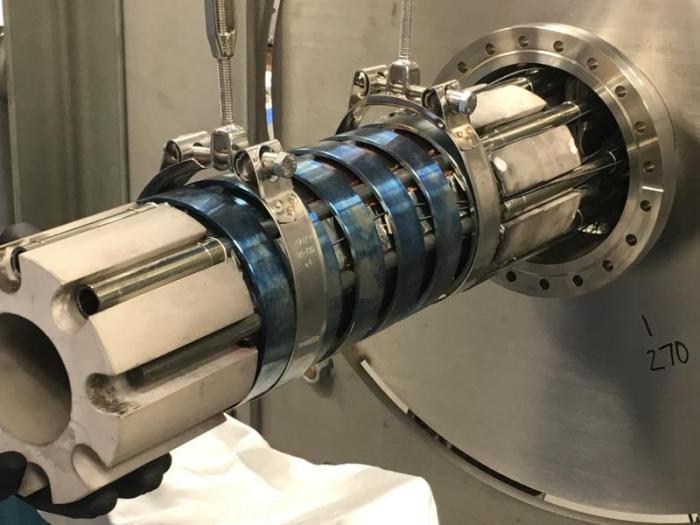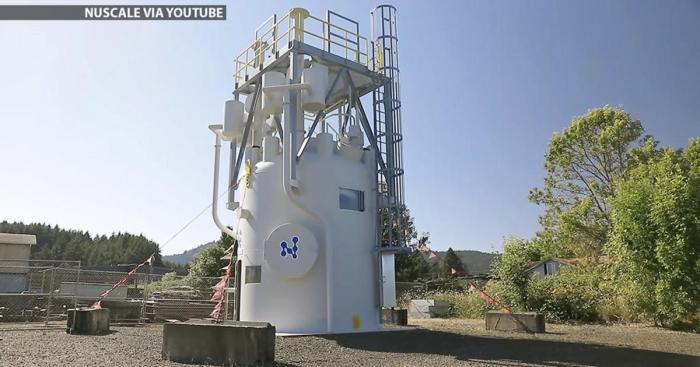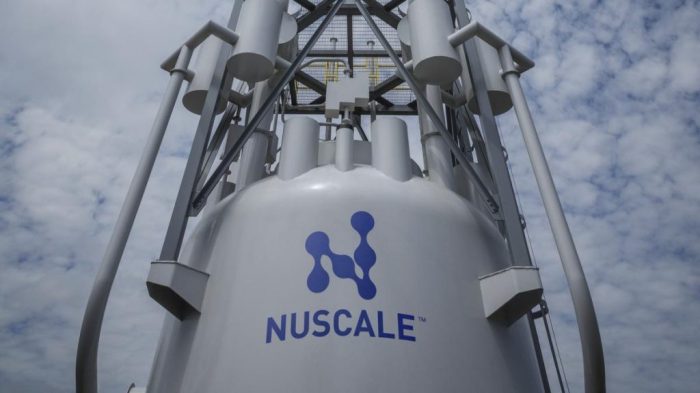Small nuclear reactors are emerging as a promising solution to the world’s energy challenges. These compact and versatile reactors offer a range of advantages over traditional nuclear power plants, including enhanced safety features, reduced costs, and the ability to be deployed in remote locations.
As the world seeks to transition to clean and sustainable energy sources, small nuclear reactors are poised to play a significant role.
The development and deployment of small nuclear reactors face several challenges, including regulatory hurdles, public acceptance, and economic viability. However, with continued research and innovation, these challenges can be overcome, paving the way for the widespread adoption of this transformative technology.
Definition and Overview of Small Nuclear Reactors
Small nuclear reactors (SMRs) are a type of nuclear reactor that is smaller and more affordable than traditional nuclear reactors. They are typically designed to generate less than 300 megawatts (MW) of electricity, compared to traditional nuclear reactors which can generate up to 1,000 MW or more.
SMRs are being developed as a way to make nuclear power more affordable and accessible. They are also being considered for use in remote areas or as a backup power source for critical infrastructure.
Types of Small Nuclear Reactor Designs
There are a variety of different SMR designs currently under development. Some of the most common types include:
- Light water reactors (LWRs): LWRs are the most common type of nuclear reactor in use today. They use ordinary water as a coolant and moderator.
- High-temperature gas-cooled reactors (HTGRs): HTGRs use helium gas as a coolant and moderator. They operate at higher temperatures than LWRs, which makes them more efficient.
- Molten salt reactors (MSRs): MSRs use molten salt as a coolant and moderator. They are inherently safe because the molten salt cannot boil or catch fire.
Advantages and Benefits of Small Nuclear Reactors
Small nuclear reactors (SMRs) offer several advantages over traditional large-scale nuclear power plants. Their compact size and modular design make them suitable for a wider range of applications, including remote locations, industrial processes, and power generation in areas with limited space.
Enhanced Safety Features
SMRs incorporate advanced safety features that minimize the risk of accidents and mitigate their consequences. These features include:
- Passive safety systems that rely on natural forces, such as gravity and convection, to cool the reactor in the event of an emergency.
- Multiple layers of containment to prevent the release of radioactive materials.
- Advanced fuel designs that enhance fuel performance and reduce the production of radioactive waste.
Flexibility and Modularity
SMRs are modular, meaning they can be built in smaller units and assembled on-site. This allows for greater flexibility in deployment and scalability, enabling utilities to adjust their power generation capacity as needed.
Reduced Construction Time and Costs
The modular design and factory fabrication of SMRs streamline the construction process, reducing construction time and costs compared to traditional nuclear power plants.
Environmental Benefits
SMRs produce low carbon emissions, making them a sustainable energy source. They also generate minimal radioactive waste, which can be safely stored and disposed of.
Applications of SMRs
SMRs have various applications, including:
- Power Generation:SMRs can provide reliable and cost-effective electricity to remote communities and islands.
- Industrial Processes:SMRs can generate heat for industrial processes, such as hydrogen production and desalination.
- Remote Locations:SMRs are ideal for remote locations where access to traditional energy sources is limited.
Challenges and Limitations of Small Nuclear Reactors

Despite the potential advantages of small nuclear reactors, their development and deployment face several challenges and limitations.
One of the primary challenges is cost. Small nuclear reactors are typically more expensive to build and operate than larger reactors, due to the need for specialized materials and components. Additionally, the regulatory process for licensing and approving small nuclear reactors can be complex and time-consuming, further increasing costs.
Regulatory Hurdles
The regulatory framework for nuclear power plants is complex and stringent, and small nuclear reactors are no exception. The process of licensing and approving a small nuclear reactor can be lengthy and expensive, and there is no guarantee that a project will ultimately be approved.
Public Acceptance
Public acceptance is another challenge that small nuclear reactors face. There is still a great deal of public concern about nuclear power, and some people are hesitant to accept the idea of small nuclear reactors being built in their communities.
Safety Concerns
Small nuclear reactors are designed to be inherently safe, but there are still some safety concerns that need to be addressed. For example, there is the potential for a reactor to overheat or lose coolant, which could lead to a release of radioactive material.
Current State and Future Prospects of Small Nuclear Reactors
The development of small nuclear reactors (SMRs) has gained significant momentum in recent years, offering the potential to address the challenges of decarbonization and energy security. Currently, several SMR designs are under development and demonstration, with a few projects entering the construction phase.
The global adoption of SMRs is expected to grow in the coming decades, driven by their advantages in terms of flexibility, safety, and cost-effectiveness. Governments and utilities in various countries are actively pursuing SMR projects, recognizing their potential to contribute to a sustainable and reliable energy mix.
Future Prospects
The future prospects of SMRs are promising, with their potential applications extending beyond electricity generation. SMRs can play a crucial role in providing heat for industrial processes, desalination, and hydrogen production. Additionally, their compact size and modular design make them suitable for deployment in remote areas, islands, and regions with limited grid infrastructure.
Research and development efforts are ongoing to enhance the performance and safety of SMRs. Innovations in materials, fuel designs, and control systems are expected to further improve the efficiency and reliability of these reactors. Collaboration between industry, academia, and research institutions is essential to accelerate the development and deployment of SMRs.
Applications and Case Studies of Small Nuclear Reactors
Small nuclear reactors offer a wide range of applications, catering to diverse energy needs across sectors. Their compact size and adaptability make them suitable for remote areas, isolated communities, and industrial facilities.
Power Generation
- Small nuclear reactors can provide reliable and cost-effective electricity in remote regions where grid connections are impractical or expensive.
- They can complement renewable energy sources like solar and wind, ensuring a stable and resilient power supply.
- Several small nuclear reactors are already operating or under construction worldwide, demonstrating their feasibility and practicality.
Desalination
- Small nuclear reactors can generate the heat and electricity required for desalination plants, producing clean water from seawater.
- In arid and water-scarce regions, this technology offers a sustainable solution to address water security challenges.
li>Pilot projects and research initiatives are underway to explore the integration of small nuclear reactors with desalination systems.
District Heating
- Small nuclear reactors can provide heat for district heating systems, supplying warmth to homes and businesses in urban areas.
- This application reduces reliance on fossil fuels and promotes energy efficiency by utilizing the heat generated from nuclear reactions.
- Several successful district heating projects utilizing small nuclear reactors have been implemented in countries like Russia and China.
Case Studies
Several notable case studies demonstrate the successful implementation of small nuclear reactors worldwide:
- Akademik Lomonosov: A floating nuclear power plant deployed in Russia’s remote Arctic region, providing electricity and heat to isolated communities.
- NuScale Power Plant: A modular reactor design in the United States, expected to be operational in the mid-2020s, providing clean energy to the Western grid.
- Shidao Bay Nuclear Power Plant: A district heating reactor in China, supplying heat to over 200,000 homes and businesses, reducing air pollution and improving energy efficiency.
Safety and Regulatory Considerations for Small Nuclear Reactors

Small nuclear reactors (SMRs) incorporate advanced safety features and stringent regulatory requirements to ensure their safe operation. Their compact design and inherent characteristics contribute to enhanced safety compared to traditional nuclear power plants.
SMRs are designed with passive safety systems that rely on natural forces, such as gravity and convection, to remove heat and prevent core damage in the event of an emergency. They often utilize multiple layers of containment and cooling systems to minimize the risk of radiation release.
Regulatory Requirements
SMRs are subject to rigorous regulatory oversight by national and international organizations, including the International Atomic Energy Agency (IAEA). These regulations cover design, construction, operation, and decommissioning to ensure compliance with safety standards.
Regulatory requirements focus on preventing and mitigating potential accidents, ensuring adequate emergency preparedness, and protecting the public and the environment from radiation exposure.
Safety Comparison with Traditional Nuclear Power Plants
Compared to traditional nuclear power plants, SMRs offer several safety advantages:
- Smaller size and lower power output:SMRs’ compact design reduces the potential consequences of an accident.
- Passive safety systems:SMRs rely on natural forces for safety, eliminating the need for complex active systems that could fail.
- Multiple layers of containment:SMRs often incorporate multiple layers of containment to prevent radiation release.
- Simplified design:SMRs’ modular and standardized design simplifies construction and operation, reducing the risk of human error.
Economic and Environmental Implications of Small Nuclear Reactors

Small nuclear reactors (SMRs) have the potential to revolutionize the energy sector, offering economic benefits and environmental advantages. Their smaller size and modular design can reduce construction costs and make them more accessible for deployment in remote or underserved areas.
One of the key economic advantages of SMRs is their cost-effectiveness. By utilizing standardized designs and mass production techniques, SMRs can achieve economies of scale, leading to lower construction and operating costs compared to traditional large-scale nuclear reactors.
Environmental Benefits
SMR technology offers significant environmental benefits. By generating electricity with minimal greenhouse gas emissions, SMRs can contribute to the fight against climate change. They also produce less radioactive waste compared to traditional nuclear reactors, reducing the need for long-term waste storage and disposal.
Additionally, SMRs can be used to provide reliable and clean energy for communities that currently rely on fossil fuels. By reducing dependence on non-renewable energy sources, SMRs can help promote energy security and sustainability.
Public Perception and Social Acceptance of Small Nuclear Reactors
Public perception and social acceptance play a crucial role in the successful deployment of small nuclear reactors. Understanding and addressing public concerns is essential for fostering trust and gaining support for this technology.
Concerns about safety, waste disposal, and potential accidents are common among the public. It is important to address these concerns through transparent communication, public engagement, and education. Open dialogue and the provision of accurate information can help build trust and dispel misconceptions.
Strategies for Addressing Concerns and Fostering Public Trust, Small nuclear reactors
- Transparent Communication:Provide clear and accurate information about the technology, its safety features, and waste management plans.
- Public Engagement:Involve the public in decision-making processes and provide opportunities for them to express their views and concerns.
- Education and Outreach:Implement educational programs and public outreach campaigns to increase understanding of nuclear energy and its benefits.
- Independent Oversight:Establish independent regulatory bodies to ensure safety and environmental compliance, fostering public confidence.
- Community Involvement:Engage local communities in the planning and development of small nuclear reactor projects, addressing their specific concerns and needs.
Conclusive Thoughts: Small Nuclear Reactors
Small nuclear reactors have the potential to revolutionize the energy landscape. Their compact size, enhanced safety features, and economic viability make them an attractive option for a wide range of applications, from power generation to remote communities and industrial processes.
As the world continues to grapple with the challenges of climate change and energy security, small nuclear reactors offer a promising path towards a clean, sustainable, and prosperous future.
Helpful Answers
What are small nuclear reactors?
Small nuclear reactors are nuclear reactors with a power output of less than 300 megawatts thermal. They are typically designed to be modular and transportable, making them suitable for a variety of applications.
What are the advantages of small nuclear reactors?
Small nuclear reactors offer several advantages over traditional nuclear power plants, including their compact size, enhanced safety features, reduced costs, and the ability to be deployed in remote locations.
What are the challenges associated with small nuclear reactors?
The development and deployment of small nuclear reactors face several challenges, including regulatory hurdles, public acceptance, and economic viability.
What is the future of small nuclear reactors?
Small nuclear reactors have the potential to play a significant role in the world’s energy future. With continued research and innovation, these challenges can be overcome, paving the way for the widespread adoption of this transformative technology.